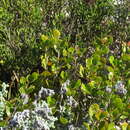fr
noms dans le fil d’Ariane


Die Blinktaaibos (Searsia lucida), voorheen Rhus lucida, is klein boompie wat in struikgewasse of woude gevind word vanaf seevlak tot so hoog as 2000 m bo seevlak. Die boompie kom voor aan die kus van Suid-Afrika vanaf Saldanhabaai tot by noord KwaZulu-Natal. Dit kom ook voor in Mpumalanga en Limpopo. Die blomme is klein en romerig wit. Die vrugte, sowat 4 mm in deursnee, word blinkbruin as hulle volwasse raak. Die boom staan ook bekend as die Wakstaaibos en in Engels as Glossy Currant.
Die Blinktaaibos (Searsia lucida), voorheen Rhus lucida, is klein boompie wat in struikgewasse of woude gevind word vanaf seevlak tot so hoog as 2000 m bo seevlak. Die boompie kom voor aan die kus van Suid-Afrika vanaf Saldanhabaai tot by noord KwaZulu-Natal. Dit kom ook voor in Mpumalanga en Limpopo. Die blomme is klein en romerig wit. Die vrugte, sowat 4 mm in deursnee, word blinkbruin as hulle volwasse raak. Die boom staan ook bekend as die Wakstaaibos en in Engels as Glossy Currant.
Searsia lucida, previously known as Rhus lucida, and commonly known as the varnished kuni-rhus (English) or blinktaaibos (Afrikaans).[1][2]
The tree seldom reaches a height of more than 2 metres and can spread as a shrub over several meters too.
The stems and branches are upright and erect. Young stems are red, shiny, resinous and sticky.
The leaves are shiny ("lucida" = "shiny"), trifoliate, leathery (sub-coriaceous), and a dark to olive green colour (often becoming orange before being shed).
The leaflets' shape is obovate-cuneate, often with small notches in their rounded tips. The leaflets are the same colour above and below, with a prominent central keel and fine lateral veins visible. Damaged leaf-surfaces become pale, almost white.
The leaf's petiole (stalk) is slightly winged, at least along its upper half.
It produces creamy-white flowers from June to October, in small, sparse, terminal inflorescences. The flowers are small, with petals less than 2 mm long.
It bears spherical fruits 4–5 mm in diameter, which are initially green and turn shiny brown as they mature (Oct-Nov). The fruits are eaten by birds.[3][4]
This species closely resembles Searsia pallens and Searsia undulata, which co-occur over much of its distribution range.
The leaf of Searsia pallens also has a 10mm petiole that is slightly winged, but it has leaflets that are much longer (40mm) than they are wide (10mm). Its leaflets have 4 to 6 lateral veins per centimeter. Searsia pallens also has glossy fruits that are 4-5mm wide, but its fruits are elliptical-ovoid.
Searsia lucida in contrast, has a rounded fruit, and fewer lateral veins on its leaves (only 2 or 3 per centimeter). The leaflets of Searsia lucida are also broader and more oval in shape.[5][6]
This small tree has a distribution along the West Coast of South Africa from Saldanha Bay around the Cape and up the East Coast almost until the Mozambique border. Its distribution area also encompasses the whole of Kwazulu-Natal and stretches in an arm past Eswatini, right up the Lowveld areas of Mpumalanga and into Limpopo Province, almost to the Zimbabwe border.
It is found in scrub or forest areas from sea level to 2000 metres above.
Searsia lucida, previously known as Rhus lucida, and commonly known as the varnished kuni-rhus (English) or blinktaaibos (Afrikaans).